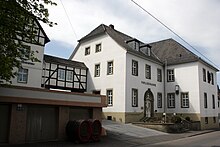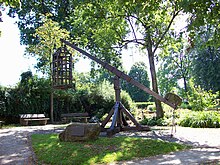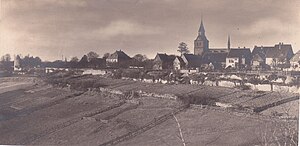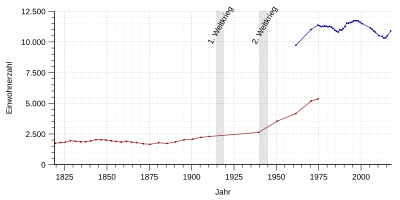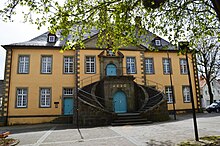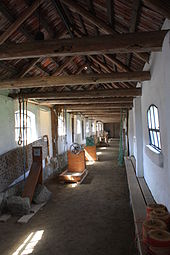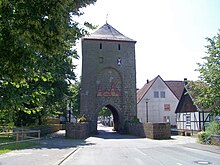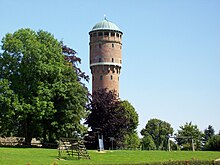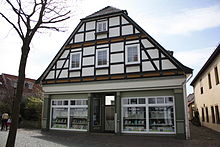Rüthen
| coat of arms | Germany map | |
|---|---|---|

|
Coordinates: 51 ° 30 ' N , 8 ° 26' E |
|
| Basic data | ||
| State : | North Rhine-Westphalia | |
| Administrative region : | Arnsberg | |
| Circle : | Soest | |
| Height : | 380 m above sea level NHN | |
| Area : | 158.15 km 2 | |
| Residents: | 10,826 (Dec. 31, 2019) | |
| Population density : | 68 inhabitants per km 2 | |
| Postal code : | 59602 | |
| Primaries : | 02952, 02902, 02954 | |
| License plate : | SO, LP | |
| Community key : | 05 9 74 036 | |
| LOCODE : | DE RUT | |
| City structure: | 15 districts or city districts | |
City administration address : |
Hochstrasse 14 59602 Rüthen |
|
| Website : | ||
| Mayor : | Peter Joseph Weiken ( independent ) | |
| Location of the city of Rüthen in the Soest district | ||

Rüthen is a town in the Soest district in North Rhine-Westphalia ( Germany ). The city of Rüthen received city rights in 1200 . In the Middle Ages , Rüthen was at times of considerable importance as the administrative center of the Duchy of Westphalia and as a Hanseatic city . Since the late Middle Ages it has developed more and more into an agricultural town . Today's city emerged from the merger of the core city with 14 previously independent municipalities. Statistically, Rüthen is now a large rural community .
geography
location
Rüthen is traversed by the Möhne , the largest river in the city, in an east-west direction . It occurs at Heidberg at 335 m above sea level. NN in the urban area and leaves it at Drewer-Heide at 294 m above sea level. NN again. The core city is located approximately in the middle of the urban area on a hill north of the Möhne.
South of the Möhne rises the Arnsberg Forest , in which the village of Kallenhardt is located. In the Arnsberg Forest, the urban area on the Wehberg reaches a height of 528.9 m above sea level. NN . The Lange Berg , northeast of the Wehberg, is 486.2 m high. Within the area belonging to the Arnsberg Forest Nature Park , the Biber and Glenne flow in a north-westerly direction. In terms of nature , this part of the urban area belongs to the North Sauerland Oberland .
The other localities of Rüthens are north of the Möhne. Up to the hairline , the terrain rises to around 380 meters. The hair strand forms the watershed between the Ruhr and the Lippe . The streams flowing north of the hair strand drain over the lip. To the north, the area falls gently towards Soester Börde . North of Westereiden lies at 129 m above sea level. NN the lowest point of the urban area on the stream of the Pöppelsche . Agricultural open land dominates . In terms of nature, the northern part of the city area belongs to the Hellwegbörden of the Westphalian Bay .
Expansion of the urban area
Today Rüthen stretches for around 22 km in a north-south direction and 11 km in a west-east direction. With 158 km², Rüthen is the largest municipality in the Soest district in terms of area. Of these, 94.15 km² (59.6%) are agricultural areas, 49.31 km² (31.2%) and 13.17 km² (8.3%) are settlement and traffic areas. Other areas account for 1%.
Neighboring communities
The place is in the south of the Soest district. In the Möhnetal it borders on the Hochsauerlandkreis . The neighboring communities clockwise from the north: Erwitte , Geseke , Büren , Brilon , Olsberg , Bestwig , Warstein , Anröchte . The city boundary between Brilon and Rüthen is formed by the Hengelsbach .
City structure
Rüthen consists of the following districts:
- Rüthen (4786 inhabitants)
- Altenrüthen (511 inhabitants)
- Drewer (703 inhabitants)
- Hemmern (167 inhabitants)
- Hoinkhausen (175 inhabitants)
- Kallenhardt (1665 inhabitants)
- Kellinghausen (86 inhabitants)
- Kneblinghausen (256 inhabitants)
- Langenstraße-Heddinghausen (446 inhabitants)
- Most (375 inhabitants)
- Menzel (383 inhabitants)
- Nettelstädt (92 inhabitants)
- Oestereiden (793 inhabitants)
- Weickede (34 inhabitants)
- Westereiden (473 inhabitants)
history
middle Ages
The namesake of today's city was the village of Altenrüthen , about two kilometers to the west , which was called Ruothino (varia) until 1200. The local parish of St. Gervasius and Protasius is the oldest in the area and was established in the first half of the 9th century as a main parish from the original parish of Erwitte . In 1072 Archbishop Anno II transferred their income to the newly founded Grafschaft monastery . In Altenrüthen there was a main court of the archbishop of Cologne. The lords of Rüdenberg had this as a fief .
In the area of today's Rüthen, the Archbishops of Cologne, as Dukes of Westphalia, initially acquired extensive property from 1180. But the Arnsberg counts also had considerable possessions there.
On September 29, 1200, Rüthen was elevated to the status of town by Archbishop Adolf I of Cologne , who as Duke of Westphalia had the right to fortify, and then continuously fortified with walls and ditches. Apparently an already existing older farm settlement of the Counts of Arnsberg was included in the new establishment. The planned new Cologne city complex is still characterized today by the clearly visible difference between the irregular street system around St. Nikolaus (with the presumed villication) and the regular and parallel streets around St. Johannes (presumed founding core from 1200). In addition to the oldest written town charter from the late 13th century, the Counts of Arnsberg initially retained a share in the town's income from the older farm estate for a few decades after it was founded. However, this privilege disappeared towards the end of the 13th century.
Rüthen was strategically located over the northern bank of the Möhne on a 38 hectare mountain ledge. The founding of the city was part of the expanding territorial policy of the Archbishops of Cologne to expand their position in Westphalia after the transfer of the title of Duke of Westphalia . The city was strategically directed against the bishops of Paderborn , the Counts of Arnsberg and the noblemen of Büren . The connection to the largest Cologne city in Westphalia, Soest, should also be secured. In addition, the area of the Arnsberg Forest in particular was to be taken over from the new city . Initially, the place even served as the seat of the Marshal of Westphalia as the representative of the Archbishop until the second half of the 13th century and was thus at times the center of power in Cologne. In front of the city in the west, a large castle complex was built as a state castle with a considerable occupation at the beginning of the 13th century . The castle team consisted of up to 12 liege recipients from the sovereign. In the second half of the 14th century, however, the castle no longer played an important strategic role for the archbishops and fell into disrepair. The city's new cemetery has been built on its site since 1826.
The Soest city law initially served as a model for Rüthen's town charter ; but it was then expanded independently. It was taken over by other cities such as Geseke, Hallenberg, Medebach, Werl, Warstein, Schmallenberg, Winterberg, Belecke and Kallenhardt. The new city itself attracted people from the surrounding area. Probably before 1300 the inhabitants of the village settlements of Haderinghausen, Schneringhusen, Wulmeringhusen and Bruerdinghusen in the Feldmark area near the city moved to the new town. The resettled new residents continued their agriculture from Rüthen. The city's sphere of influence has also included three villages and three individually located farms since at least the early 16th century. In times of need, its residents found protection in the city as "stake citizens" (= citizens of minor rights), but in return they had to do a number of fixed manual and tensioning services for the Rüthen magistrate.
Although initially developed for strategic reasons, the place itself also benefited from its location between Hellweg and Bergland. This soon made it possible to develop a diversified economic life. The focus was on general agriculture as well as sheep farming and wool production. Rüthen developed into an important market town for eastern and south-eastern Westphalia as far as nearby Hesse. The trading radius for their own goods, however, was much more limited. From 1469 the place was a member of the Hanseatic League . Rüthen was a member of Soest. Warstein, Kallenhardt and Belecke were subordinate to him as the places facing him. The fact that there were two parishes (St. John and St. Nikolaus), which were administered by only one pastor, also speaks for the upward trend. A hospital was built in the city from 1420 , and shelter for lepers was built outside the city . An Augustinian convent was built around 1480. In the following centuries, however, the importance of Rüthen decreased significantly. Foreign trade weakened as early as the late 16th century, and since the 17th century the handicrafts organized in guilds had hardly any significance beyond the Gogericht Rüthen as the closer environment of the city.
Modern times
Despite the economic stagnation, the political position, the craft structures and the relatively favorable agricultural conditions meant that the place was one of the most important cities in the Duchy of Westphalia even in the early modern period. The treasury register of 1536 produced a tax revenue of 250 guilders. This was less than Geseke and Werl, for example, but significantly more than in the other cities. Arnsberg only brought it to about 40 guilders.
A small group of wealthy families held power in Rüthen until the end of the 16th century. The so-called civil dispute arose against these since 1577 as part of the nationwide "Truchsessische Wirren", which came from the complaint of the local rifle brotherhood against the magistrate. Among other things, it was about the fattening and pasture options, the use of the forest and similar problems. The council turned in vain to the sovereign to resolve the conflict. Finally, in 1580, during the council elections, there were unrest and the newly elected councilors were driven out by the majority of the population. As a result, the sovereign administration tried harder to settle the conflict. They culminated in 1584 in the award of a new council election order, which introduced the principle of rotation for the mayor and the magistrates' offices.
There were also conflicts against the sovereign's attempt to extend his jurisdiction over the villages belonging to the city. They ended with a success in Rüthens after the official court in Werl was appealed to in 1637.
Around 1625 the plague raged in Rüthen. The city lost about a quarter of its inhabitants, so that the city council vowed the annual "praise procession", which takes place to this day with great sympathy of the population and the political representatives: "In the year 1625 God had a terrible plague epidemic Rüthen. Many people were moved from the earthly valley of tears to the place of eternal rest. In order to avert such a punishment from God, the honorable city council and a community committee have met at the town hall, St. Sebastian and St. Fabian as patron saints elected and vowed to honor them every year with a procession from the Upper Church (St. Nicholas) to the Lower Church (St. John) and a feeding of the poor in front of the town hall, after they had made this vow and solemnly fulfilled the promised the plague epidemic suddenly followed, and all sick people recovered. "
Witch trials
Like other places in the Electoral Cologne Duchy of Westphalia and Central Europe, the city was the scene of witch trials in the early modern period. From 1573 to 1664, 104 witch trials were carried out in the city and in the Gogericht Rüthen . At least 167 people were executed. Only a few people, such as Freunnd Happen , accused during the witch hunts in Rüthen, defied the torture and managed to contradict the charge of guilt. After two months of imprisonment and three severe tortures, Freunnd Happen was finally released on September 23, 1660.
The bronze relief for Friedrich Spee and the Hirschberg pastor Michael Stappert commemorates the work of opponents of the witch hunt on the witch tower in Rüthen . On March 31, 2011, the city council of Rüthen decided on a socio-ethical rehabilitation of all innocent people who were convicted and executed in the area of today's city of Rüthen during the 16th and 17th centuries as part of the witch persecution.
17th and 18th centuries
After the demographic decline caused by the Thirty Years' War , the plague of 1625 and a major city fire in 1654, only 270 households with 1050 residents can be found in Rüthen in 1670. A total of 416 houses were counted, of which 143 were uninhabited at the time. The number of inhabitants then rose to around 1200-1300 inhabitants in 359 households by 1717. In 1759 there were 1,431 inhabitants, including 43 Jews and 427 children under the age of 12. By 1818 the population had grown to 1714, roughly the same number as before the Thirty Years' War . During this time, Rüthen had around 400 residential buildings. In the second half of the 17th century, Rüthen developed into a center for the construction industry for churches, town halls, castles and monasteries. Due to the Rüthen green sandstone , numerous foreign sculptors and stone carvers, bricklayers as well as painters and wood carvers settled in Rüthen, "which in the construction boom after the Thirty Years' War through the sandstone quarries [almost] became an Eldorado" for these professional groups. For example, the stone carver Bartolomeo Rabaliatti , father of the famous master builder Franz Wilhelm Rabaliatti . In 1703 he immigrated from the Ferrara area, acquired citizenship in Rüthen and married Elisabeth Hartmann. In the Duchy of Westphalia a large number of well-known historical monuments were made from the green sandstone by Rüthener craftsmen up to around 1750 and a number of churches and chapels were equipped with their artistic woodwork and painting.
The city had only a small wealthy upper class (more than 5 Reichstaler tax sum), which in 1759 made up about 7%. The majority of city dwellers (89.9%) paid taxes, but the social gap was wide. After all, almost half of the residents lived in small circumstances. In contrast, the number of residents who actually belong to the poor household was very low at just over 3%. A considerable part of the population (42%) made a living from handicrafts in the 18th century. The service occupations in the broadest sense came to 11%. Retail was less represented at 5%. The situation of the brewers can be assessed as particularly precarious, who experimented a lot in the 17th century, as they had to struggle with inadequate water quality and were accordingly often fined by the city council for inadequate quality of the beer, as Ulrich Grun demonstrated. while the same city council liked to import beer from Paderborn or even from Bavaria on festive occasions and thus weakened the local economy itself. Apparently, this problem could not be solved in the period that followed. Even in the minutes of the Bürgerschützen from 1855 it was quite frankly stated: "With regard to the beer, because the required quality was not available here, it was decided to order the same from Brenken (zu Erpernburg) ...".
In the different phases of the Thirty Years War, the city was affected by the war events. In 1644 z. B. the Swedish General Douglas marched after the conquest of Obermarsberg to Arnsberg also via Rüthen. The city was badly plundered. In 1654 a Capuchin monastery was founded. A severe epidemic of the Red Ruhr broke out in 1673. The first normal school for teacher training in the Duchy of Westphalia was opened by Friedrich Adolf Sauer , who had been appointed pastor in Rüthen and where he met the school reformer Melchior Ludolf Herold , in 1795 in Rüthen in the building of the former Ursuline monastery (today Volksbank).
Similar to the 16th century, there were complaints from the citizens in 1734. Among other things, the magistrate was accused of wasting taxes. The allegations were investigated by the sovereign administration, but had no consequences for the old council system.
19th and 20th centuries
In 1802 the city came with the Duchy of Westphalia to the Landgraviate of Hesse and in 1816 to Prussia.
Even in the 19th century and well into the 20th century, Rüthen remained predominantly agricultural. The first house outside of the old city fortifications was built around 1850. It was not until the railway connection of 1898/99 that industrialization was made possible with a few sawmills near the train station and the expansion of green sandstone mining.
In Rüthen there was a teachers' seminar from 1876 to 1926, which brought about an economic revival for the inner city.
As a city that was still almost entirely Catholic in the first half of the 20th century, the center party dominated politically . In 1924, 80% of the voters still voted for the center. In the Reichstag election in March 1933 , the party got 55% of the vote. However, the NSDAP came to 30.2%. This was significantly more than in other Catholic regions of the Sauerland. At the beginning of the National Socialist era, six residents from Rüthen were imprisoned in the Benninghausen concentration camp in 1933 . The US Army occupied Rüthen on April 1, 1945 without major fighting. On April 6th, Kallenhardt occupied the southern part of the city.
Incorporations
The municipality was created in its current form in the course of the municipal reform that came into force on January 1, 1975, from the 15 independent municipalities Altenrüthen, Drewer, Hemmern, Hoinkhausen, Kallenhardt, Kellinghausen, Kneblinghausen, Langenstraße-Heddinghausen, Meiste, Menzel, Nettelstädt , Oestereiden, Rüthen, Weickede and Westereiden. In addition, there were small uninhabited areas of the dissolved communities of Effeln and Suttrop. Drewer ceded an area of 19 hectares with 16 inhabitants at the time to the city of Warstein.
Population development
Rüthen according to the territorial status at that time
|
|
|
|
Rüthen according to the current territorial status
|
|
|
|
with all districts
The population density is comparatively low at 66.3 inhabitants per km² (Soest district 229.1, NRW 523.4). The population density is also very low in comparison with the average of the comparable municipalities in North Rhine-Westphalia (147.7). The population development has been declining for years as a result of a negative birth and migration balance. In 2010 there was a loss of 1.6%.
Religions
As part of the former Duchy of Westphalia, Rüthen is traditionally Catholic; 73% of the population are Catholic. Another 15% are Protestant. Around 12% have a different belief or are non-denominational. The Catholic parishes have come together to form the Rüthen Pastoral Association. This belongs to the deanery Rüthen-Lippstadt in the Archdiocese of Paderborn . There are a total of eleven Catholic church buildings in the city area.
For the Protestant Christians in the south, there is the parish of Rüthen, which belongs to the Protestant parish Warstein in the parish of Arnsberg, with two churches. The villages in the north of Rüthen are part of the parish of Anröchte, which belongs to the Protestant parish of Erwitte in the parish of Soest. Both church districts belong to the Evangelical Church of Westphalia .
For Rüthen there are isolated reports about Jewish life from the 13th and 15th centuries, before a community was established, permanently verifiable since 1587 . An impressive burial place in the former city moat still bears witness to it today, while the synagogue was destroyed by the National Socialists in 1938 and the community destroyed in 1942.
politics
City council
Composition of the city council after the local elections on May 25, 2014 :
| Party / group | Seats |
|---|---|
| CDU | 15th |
| SPD | 6th |
| BG | 5 |
| FDP | 2 |
City tip
After the Second World War, the north German council constitution in North Rhine-Westphalia introduced a dual leadership consisting of an honorary mayor as chairman of the council and representative of the city and a full-time head of administration ( city director , official director ). A modified form of the southern German council constitution has been in force in North Rhine-Westphalia since the 1990s . Then the dual leadership of mayor and city director was abolished. The position of the mayor has been strengthened. Since then, he has been a full-time election officer and at the same time chairman of the city council.
Mayor before 1945
- 1243 Gerlacus, magister consulum
The mayors from 1282 onwards come from the following list, which is taken from Bender's work on Rüthen:
- 1282 Vollandus de Langenstrut
- 1307 Godefridus de Ulde consul
- 1312 Gobelinus de Ulde proconsul
- 1315 Gobelinus Dobber proconsul
- 1322 Lutbertus de Attachments proconsul
- 1330 Arnoldus de Bruwerdinchusen proconsul
- 1334 Dethmar de Bruninchusen proconsul
- 1338. Friedrich de Melderich and Gerhardus de Ruden proconsules and Gerhard. de Heddinghausen consul
- 1339 Rud. de Eyerdinghausen consul
- 1350 Fried. de Sassendorf consul
- 1355 Gerhardus de Yeschen and Georgius de Bruerdinghusen
- 1359 Gerh. de Yeischen
- 1372 Frider. Volquini proconsul
- 1377 Frid. Volquini de Nettelsteden proconsul - also called Nölke Schutten Mayor .
- 1385 Conrad Porboningh consul
- 1417 Rudol. Vollenspieth consul
- 1442 Erenfridus Droste consul
- 1444 Joannes vom Röde consul
- 1454 Gerh. de Calle Burgimagister
- 1458 Joh. De Eppen consul
- 1458 Hunolt Greve Borgermester
- 1464 Hunolt Greve Burgerm.
- 1474 Gobelinus de Calle consul
- 1490 Volpert Holt forests and Volpert Bever Linck Burgermeister
- 1503 Herbols of Loen Brgm.
- 1506 Gert von Loen mayor
- 1511 Joh. Ruberg mayor
- 1518 Tilman Hartman's mayor
- 1541 Joh. Von Loen Mayor , Bern Kramer gnt. Hartmann mayor
- around 1581 Weidemann mayor
- 1583 Joh. Prangen mayor
- 1584 Joh. Hartmann, Christ. Hartmann and Helmig von Loen Burgermeister
- 1590 Johann Kramer, Helwig, also Henning von Loen mayor
- 1602 Hermann Rechelmann mayor
- around 1608 Florken
- 1608 and 1614. Dr. Conrad Koch mayor
- 1611 Tonnis from Loen mayor . also called Henning Schlaun, Caspar von Loen, Jobst Bessen
- 1630 Conrad Röingh consul
- 1640 Joh. Schreiber mayor
- 1652 and 1656 Christoph Brandis mayor
- 1652 and more often Conrad Röingh
- 1673 Johann Godfried von Loen
- 1683 Joh. Phil. Schlaun
- 1692 and 1704. Wern. Joach. Wickede, Johann von Loen † 1704, Johann Diedrich Wickede
- 1720 Hermann Hake and JO Wilthelm consuls
- 1727 Hermann Diedrich Vasbach mayor
- 1730 Around this time: Wilhelm and Anton Tutel
- 1750 Franz Caspar Röingh
- 1763 Conrad Joseph Drosemeyer
- 1764 Theodor Anton Jaeger consul
- 1766 Thomas Canisius mayor
- 1781 Franz Canisius mayor
- 1780 Anton Joseph Graes mayor
- 1783 Friedrich Mathias Canisius Bgmstr.
- 1790 Friedrich Ferdinand Graes consul regens ; YES Offermann's proconsul
- 1790 Memering Mayor
- 1797 Offermann mayor
- 1806 J. Förstige and A. Möning mayors
- 1808 Caspar Anton Förstige, last mayor and first city school in Hesse
- 1822 Evertsbusch
- 1827 Mayor of Rühl
- 1838 Jungeblodt mayor
Mayor after 1945
- Johannes Krüper (1946–1948)
- Josef Flormann (1948–1952)
- Ewald Wenge (1952–1969)
- Josef Kösters (1969–1979)
- Rolf Gockel (1979–1999)
- Rudolf Schieren (full-time mayor 1999–2009)
- Peter Joseph Weiken (full-time mayor since 2009)
Official and City Directors
- Wilhelm Gipkens (Mayor 1945, Official Director 1946–1948)
- Heinrich Kersting (Official Director 1949)
- Franz Kooke (Official Director 1950–1974)
- Ewald Tiggemann (Official Director 1974, City Director 1975–1979)
- Georg Voss (City Director 1979–1991)
- Rudolf Schieren (City Director 1991–1999)
coat of arms
Blazon :
A continuous black cross in silver with a red diamond at the intersection and angled by four red diamonds.
Description:
The depiction of the coat of arms corresponds to the court seal of 1549. The cross is the sovereign cross of the Electorate of Cologne. The five diamonds should be a speaking symbol for the place name (Rüthen = diamonds). The official approval took place on January 28, 1911.
Town twinning
Since 1983 there has been a twinning with the eastern English city of Dereham (150 km north of London ), which gave the place a British telephone booth, and since August 30, 1991 a twinning with the Saxon-Anhalt city of Egeln (25 km southwest of Magdeburg ) .
Culture and sights
theatre
The city does not have its own theater. Theater performances are carried out by the Jodocus Theater in Rüthen under the auspices of the Rüthen Kulturring. Modern chamber theater and cabaret are performed in the old town hall and in the old auditorium of the grammar school in Rüthen. There is also the Spectaculum theater group from the Friedrich-Spee-Gymnasium Rüthen. There are also performances by other public school groups.
Museums
The Rüthener museum room, located in a former brewery , has been showing objects from the history of Rüthen on 100 m² of exhibition space since 2005. One focus of the museum is the fossils and minerals collection from the Rüthen area, another focus is the expansion of electricity in Rüthen. Changing special exhibitions are shown in the entrance area.
In the building of the old rope factory from 1914, old tools and equipment of the rope trade have been exhibited since 2003.
music
Ecclesiastical and secular music have been performed by the Rüthen Chamber Choir since 1963 . Concert tours have taken the choir to Austria, France and Slovenia, among others.
The Bergstadt musicians Rüthen can look back on a history of over 100 years. In 1992 the association was awarded the Pro Musica badge . The repertoire of the brass band includes marching, dance and church music. In addition to the Bergstadtmusikanten there is the Wind Orchestra Instrumentalverein Harmonie Altenrüthen founded in 1901 in the Altenrüthen district . In the Kallenhardt district, the Kallenhardt wind and dance orchestra plays , which can look back in history to the year 1829. The club also has a youth orchestra in which you can play up to the age of 25.
The Rüthen Tambour Corps were founded in 1878. At first the band consisted only of male musicians. In 1970, a young band of young players appeared for the first time. In 1994 girls were trained in the club for the first time and are part of the Rüthen drum corps.
Buildings
From the medieval city fortifications , the Hachtor and the semicircular witch's tower have been preserved in addition to the extensive remains of the city wall that was built in the 14th century . The Hachtor (detention gate) also served as a prison. Today the city wall forms a circular route around the historic city center with good views of the surrounding area. In 1991 the eighth happiness award of the persecuted and slandered was depicted in a bronze relief on the Hexenturm with portraits of the Jesuit father Friedrich Spee and the Hirschberg pastor Michael Stappert (Michael Stapirius), who was born in Rüthen . There was originally an Augustinian convent established in 1482 on Hachtorstrasse, but it burned down in 1739. In the same place, an Ursuline monastery was built in 1749, which was dissolved again in 1772. The simple, plastered baroque building is now used by a bank.
The old town hall is a plastered building, designated in 1730, with gabled central risers , which is characterized by a large, curved flight of stairs. The building was created in 1726–1730 according to plans by the builder Michael Spanner , who came from Erwitte and who also built the abbey building in Liesborn , the Grafschaft monastery and Almerfeld house.
The two-bay hall church of St. Nicholas with a square west tower was probably built in the third quarter of the 13th century after a fire. In 1712 the tower was given its current baroque helmet. Inside there is a baroque altar from Anröchte , which was created by JC Haane in 1771. The side altars and the pulpit by Paul Gladbach are likely to have been built around 1680. The southern altar is inscribed in 1730.
The neo-Gothic nave of St. John the Baptist was built in 1871–1874 according to plans by Arnold Güldenpfennig . The mighty west tower dates from 1737. Inside the Marienkapelle in front of the tower there is a Madonna sculpture called “Maria vom Stein”. The miraculous image was revised towards the end of the 19th century.
A three-winged building complex has been preserved from the Capuchin monastery , which was the seat of the Capuchin Order between 1675 and 1804. The monastery church, which was demolished in 1834 and of which only the entrance portal has survived, joined in the north. Today it forms the entrance to the Rüthener Stadtfriedhof. The entire monastery complex was built according to plans by the well-known master builder Ambrosius von Oelde . From 1839 to 1967 the monastery buildings were used as a regional, city and district court. After standing empty for many years, 13 rental apartments were finally set up in them in 1996.
Also worth seeing is the Jewish cemetery with gravestones from the 17th to 20th centuries. It was built in 1625 in the former moat directly in front of the Hachtor. The cemetery is considered the oldest Jewish burial place in Westphalia. The chairmen of the Rüthen Jewish community agreed, as Ulrich Grun has shown, with the mayor of the city in accordance with the council minutes of October 8, 1625, "that in future they will bury their dead without hindrance in the [city] ditch near the old burial site and can and like to lie down ... ". The city's former synagogue is located in Hochstraße . A memorial plaque indicates the building that was converted into a residential and commercial building after the war.
On the southern edge of the city center, on the city wall, is the 35.9 meter high water tower of Rüthen , which was built in 1909 by the Kassel engineer pawn shops in brick construction. It has a viewing platform that is accessible to visitors.
There are also several residential buildings worth seeing in Rüthen. The two-storey half-timbered hall house with storage floor in Hachtorstrasse 20 (Buuck house) was built in 1609. The oldest preserved house in the city was built by the Rüthener Forum für Stadtentwicklung e. V. extensively renovated. Among other things, it houses an information center and an urban development office. In addition, it serves as accommodation for cyclists and hikers and as a multi-generation house. The half-timbered hall house with stone work in Niedere Straße 6 is dated from 1684. The former gatehouse at Hachtor (Hachtorstraße 1) went into private ownership of the master brewer Matthias Helle, who sold it to the Ohrmann family in 1835. In the same year it was rebuilt after a fire. A private investor completely renovated the house in 2010.
In the Kallenhardt district , the Körtlinghausen Castle (1714), the baroque style Catholic church (1722) and the local town hall from the 14th / 15th centuries are impressive . Century. The Kneblinghausen Roman camp is located in the Kneblinghausen district .
Nature and landscape protection
The south of the urban area is part of the Arnsberg Forest Nature Park . Other parts of the urban area of Rüthen are designated as landscape protection areas. Rüthen also has eight areas which have been designated as a nature reserve (NSG). Six of these have been designated both as a nature reserve and a European protected area ( FFH area ). Three of the nature reserves have parts of the protected areas in other urban areas. These are the nature reserves Lörmeckal (265 ha, sub-area in the Warstein urban area), Eringerfelder Wald-Süd (212.2 ha, sub-area in the Geseke urban area), Möhnetal (154.7 ha), Aschenhütte and the Romecke creek systems (39.7 ha) ha), limestone grasslands near Rüthen-Meiste (6.3 ha), Höhle am Kattenstein (0.3 ha), Drewer quarries (9.7 ha, part of the Warstein urban area, no FFH area) and Hengelsbach (2.12 ha , no FFH area).
In the Lörmecketal nature reserve southwest of Kallenhardt is the Hohler Stein cave , which has archaeological finds from the end of the Paleolithic to the pre-Roman Iron Age . There are some legally protected biotopes and natural monuments in the urban area . In addition to other bird species, the large bird species black stork , eagle owl , common raven and red kite occur in Rüthen .
Sports
The forest outdoor pool with a giant slide is very popular in the region. Further sports facilities include a go- kart track , shooting range, tennis courts, a teaching pool and a riding hall. There are several sports halls and fields in the city center and in the districts. In Kallenhardt there is a winter sports area with a ski slope with a drag lift, a toboggan run, a cross-country ski run and a bike park .
Regular events
The annual praise procession goes back to a “hagelvyre” in 1350 . It has existed in its current form since the year of the plague in 1625. The annual festival of the Citizens' Guard, which has existed for over 500 years, or the annual guild day for carpenters on the patronage festival, St. Carnival is celebrated with a Rose Monday procession, among other things .
The autumn fair with Marienmarkt usually takes place in September . The fair has been held by an association of merchants since the 1930s. In 1957 the name Marienmarkt appears in a cash report of the advertising association . However, it is not clear how far back the historical roots of the market go. The city had already had the right to hold two annual fairs since 1532. It is uncertain whether one of these markets or one of the regular cattle markets is the origin of the Marienmarkt. The Marienmarkt has been organized by the city since 2009 .
Economy and Infrastructure
In economic terms, Rüthen is currently characterized by medium-sized companies from various industries. The most important are the wood, metal, electrical and plastics industries. The Rüthener Forest is an important economic factor as a supplier of raw materials for the wood industry. The place owns the third largest municipal forest in North Rhine-Westphalia. In the Middle Ages, the extraction and processing of Rüthener sandstone was of great economic importance for the place.
In 2002, Rüthen had 2352 employees subject to social security contributions. The manufacturing sector accounted for 1383, followed by construction with 272 and services without taking public administrations into account with 216 employees.
traffic
Road traffic
Rüthen is on the federal motorway 44 , but does not have its own exit. The closest exits are Anröchte in the west and Geseke in the east. Rüthen can be reached from Brilon via federal highway 516 , which leaves the urban area east of Belecke. State and district roads are responsible for further development of the municipality.
Transportation
The following bus routes exist in Rüthen:
- Regiobus R71 from Belecke via Drewer, Altenrüthen to Rüthen, on Sundays in the summer months as a bicycle bus via Heidberg to Brilon
- Regiobus R62 from Rüthen via Menzel, Oestereiden, Bökenförde to Lippstadt
- Regiobus R77 from Rüthen via Kallenhardt to Warstein
- 466 from Hemmern to Büren (only on school days)
- 558 from Anröchte to Oestereiden or via Menzel to Effeln (only on school days)
- 672 from Rüthen via Menzel to Oestereiden (only on school days)
- 673 from Rüthen via Meiste to Oestereiden
- Taxibus T71 from Rüthen to Heidberg
Lines 558, R71 and T71 are operated by Regionalverkehr Ruhr-Lippe GmbH , the concession for lines R62, R77, 672 and 673 is owned by Busverkehr Ruhr-Sieg , and the operator of line 466 is BahnBus Hochstift .
Rail transport
The nearest IC train station is in Lippstadt .
The city also has a train station on the Möhnetalbahn Soest - Belecke - Brilon -Stadt; however, this route is no longer used for passenger transport. It has been closed and dismantled between Rüthen and Brilon Stadt. The remainder between Rüthen and Belecke was renovated in 2007. There the Westfälische Landes-Eisenbahn carries out consumer goods traffic .
Air traffic
The Paderborn / Lippstadt airport is about 20 km away.
media
" Der Patriot ", the " Westfalenpost " and the " Westfälische Rundschau " appear as regional daily newspapers in Rüthen . Incidentally, the " weekly tip " has been held in the city since 1997 on Wednesdays . The local radio for NRW is broadcast in the Rüthen area by the Hellweg Radio station.
Public facilities
The city library is sponsored by the Catholic parish of St. Johannes and Nikolaus Rüthen. Twenty volunteers provide access to around 5000 media.
From 1958 to 1978 there was a municipal hospital in Rüthen. Since then, inpatient care has been taken over by the hospitals in Brilon, Erwitte, Lippstadt, Soest and Warstein.
The Rüthen volunteer fire brigade, which is divided into three fire engines, which are distributed across the entire city by seven fire fighting groups, ensures that all districts are optimally supplied. Some units have special vehicles and special equipment for, among other things, accidents involving dangerous goods.
education
In Rüthen there is a grammar school, the municipal Friedrich-Spee-Gymnasium. In 2001 a group of students from Friedrich-Spee-Gymnasium developed the PC game "Rüthen - The Game", a historical fantasy learning game with numerous facts about the city and urban development, which was produced with a film team at all important locations in the city. The game was sold locally on a larger scale and received an award from the Friedrich-Spee-Gymnasium for its playful introduction to the city's history. In 2011, class 8 initiated the rehabilitation of the victims of the witch trials in Rüthen with a submission to the city council , which was broadcast by WDR-TV and picked up by numerous municipalities.
Until the end of the school year 2018/19 there was the Maximilian-Kolbe-Schule in Rüthen, a municipal school with a secondary school and a secondary school (secondary level I). The building, owned by the city of Rüthen, is now used by the private secondary school founded in 2014. In the center of the city there is the municipal Nikolausgrundschule with an open all-day elementary school operated by Caritas Soest. The Catholic elementary school is located in the district of Kallenhardt and is part of the school network with the municipal Nikolausgrundschule. The municipal Luzia community elementary school is located in the Ostereiden district.
Vocational and vocational schools are located in the neighboring cities of Lippstadt and Soest. The educational offer of an adult education center is covered by the adult education center Lippstadt. Music education in Rüthen has been taking place since 1985, as there is no municipal music school, in the so-called "Klingende Haus", a privately run company. In local music associations there is also musical training, for example in marching bands and brass bands.
Personalities
The city of Rüthen has four honorary citizens, including the late artist and art teacher Eduard Bufé and the late rector Eberhard Henneböle (1891–1979).
sons and daughters of the town
- Michael Stappert (around 1585/90 - 1663), country pastor and critic of the witch hunt
- Grete Adrian (1610-1665), accused in a witch trial as a werewolf , was executed in 1665
- Freunnd Happen , indicted in a witch trial, was released in 1660
- Paul Gladbach (around 1680), sculptor and carver
- Lay brother Stephan (1688–1732), Capuchin lay brother and sculptor
- Jürgen Augustinowitz (* 1964), CDU politician, Member of the Bundestag from 1990 to 1998
- Franz Wilhelm Rabaliatti , master builder
- Anton Kopp (1796–1870), Vicar General of Chicago, founder of Westphalia (Michigan)
- Hermann Roeren (1844–1920), lawyer and member of the Reichstag
- Wilhelm Gössmann (1926–2019), literary scholar
- Ulrich Ernst (* 1944), Germanist
- Harald Biermann (* 1966), historian
Personalities who have worked on site
- Christoph Brandis († 1658), mayor and historian
- Vincentius Bartholomäus Rabaliatti (from 1703 in Rüthen), stone cutter, father of Franz Wilhelm Rabaliatti
- Wilhelm Hutzier (died 1717), painter of church interiors (e.g. by Paul Gladbach)
- Melchior Klug (around 1720), stone carver
- Eberhard Henneböle (1891–1979) was a German elementary school director, home nurse and researcher and an honorary citizen of the city of Rüthen
- Eduard Bufé , (1898–1982), artist and art educator and honorary citizen of the city
- Friedrich Adolf Sauer (1765–1839), was a pastor in Rüthen, educator and school reformer
- Franz Hoischen (1903–1969), painter, graphic artist and art teacher
- Karl Rainer (1910–1999) painter and graphic artist
- Ferdinand Koch (1927–1990), tenor and music teacher
- Ulrich Grun (1937–2017), (art) historian, educator and local researcher
- Stefan Gödde (* 1975), TV presenter, grew up in Rüthen
- Marcel Höttecke (* 1987), soccer player, started at TSV Rüthen
literature
Older literature (before 1945)
- Joseph Bender : History of the city of Rüden: a representation of its institutions, their community relations with the rural communities, and their fates; together with a history of the male knight families. Werl 1848 ( full text ).
- Christoph Brandis: History of the city of male dogs. [Around 1650], printed in: Johann Suibert Seibertz : Sources for Westphalian History, Vol. 1. Arnsberg 1857, pp. 221–318 ( full text ).
- Joseph Preising (Ed.): Rüthen in historical individual images. Lippstadt 1924 ( full text ).
Modern literature (after 1945)
- Wolfgang Bockhorst, Wolfgang Maron (Hrsg.): History of the city of Rüthen . Studies and sources on Westphalian history, vol. 37. Bonifatius Verlag, Paderborn 2000, ISBN 3-89710-141-6 .
- Adolf Cramer: Memory of my youth in Rüthen 1934–1948. Norderstedt 2008, ISBN 978-3-8370-6226-7 .
- Walter Dalhoff and Franz Kooke: 775 years of the city of Rüthen. Ruethen 1975.
- Ulrich Grun (Ed.): Rüthen - Pictures from bygone days. Geiger Verlag, Horb am Neckar 1988, ISBN 3-89264-200-1 .
- Ulrich Grun: Lobetag in Rüthen , in: Soest district (ed.): Calendar of the Soest district , Soest 1996, ZDB -ID, 619151-4 , ISBN 3-928295-27-6 , pp. 50–52.
- Ulrich Grun: Where hops and malt were lost [Rüthener beer from 1600 to 1900] , in: Soest district (ed.): Calendar of the Soest district , Soest 1997 ZDB -ID 619151-4 , ISBN 3-928295-28-4 , Pp. 51-54.
- Ulrich Grun: The Judenhagen in Rüthen: "More important than a synagogue" - since 1625 burial place. In: District of Soest (ed.): Calendar of the district of Soest. Soest 2003, ISBN 3-928295-38-1 , pp. 76-77.
- Eberhard Henneböle: stone carver , carver and painter in Rüthen after the Thirty Years War until around 1750 - Rüthen as a building center. Contributions to the local history of the district of Lippstadt, booklet 5. Ed. From the district of Lippstadt in connection with the district home keeper, CJ Laumanns, Lippstadt 1974.
- Wolfgang Köhler: The statutory rights of the city of Rüthen . Dissertation, Bonn 1996.
- Manfred Schöne: The Duchy of Westphalia under Hesse-Darmstadt rule 1802–1816 , Olpe 1966.
- Elisabeth Schumacher: Cologne's Westphalia in the Age of Enlightenment , Olpe 1967.
Web links
- City homepage
- Documents from the Rüthen City Archives / Digital Westphalian Document Database (DWUD)
- Rüthener dialect with Alfons Kirsch († July 19, 2003) audible!
- Deeds from the archive of Schloss Körtlinghausen near Rüthen / digital Westphalian document database (DWUD)
- Rüthen in the Westphalia Culture Atlas
Individual evidence
- ↑ Population of the municipalities of North Rhine-Westphalia on December 31, 2019 - update of the population based on the census of May 9, 2011. State Office for Information and Technology North Rhine-Westphalia (IT.NRW), accessed on June 17, 2020 . ( Help on this )
- ↑ a b c d Rüthen municipal profile ( Memento from July 4, 2015 in the Internet Archive ) (PDF; 220 kB)
- ↑ Cornelia Kneppe: Castles and cities as crystallization points of rule between 1100 and 1300. In: Harm Klueting (Hrsg.): Das Herzogtum Westfalen, Vol. 1: Das Herzogtum Westfalen: The Electorate of Cologne from the beginnings of Cologne rule in southern Westphalia to Secularization 1803. Münster 2009, p. 218f.
- ↑ Cornelia Kneppe: Castles and cities as crystallization points of rule between 1100 and 1300. In: Harm Klueting (Hrsg.): Das Herzogtum Westfalen, Vol. 1: Das Herzogtum Westfalen: The Electorate of Cologne from the beginnings of Cologne rule in southern Westphalia to Secularization 1803. Münster 2009, p. 219.
- ↑ a b Jens Foken: Solidified Middle Ages. The cities and freedoms of the Duchy of Westphalia in the early modern period. In: Harm Klueting (Ed.): The Duchy of Westphalia. Vol. 1: The Duchy of Westphalia: The Electorate of Cologne from the beginnings of Cologne rule in southern Westphalia to secularization in 1803. Münster 2009, p. 371.
- ↑ Handbook of Historic Places in Germany, Vol. 3. Stuttgart 1978.
- ↑ Jens Foken: Solidified Middle Ages. The cities and freedoms of the Duchy of Westphalia in the early modern period. In: Harm Klueting (Ed.): The Duchy of Westphalia. Vol. 1: The Duchy of Westphalia: The Electoral Cologne Westphalia from the beginnings of Cologne rule in southern Westphalia to secularization in 1803. Münster 2009, p. 388.
- ↑ Jens Foken: Solidified Middle Ages. The cities and freedoms of the Duchy of Westphalia in the early modern period. In: Harm Klueting (Ed.): The Duchy of Westphalia. Vol. 1: The Duchy of Westphalia: Westphalia from the Electorate of Cologne from the beginnings of Cologne rule in southern Westphalia to secularization in 1803. Münster 2009, p. 399.
- ↑ Jens Foken: Solidified Middle Ages. The cities and freedoms of the Duchy of Westphalia in the early modern period. In: Harm Klueting (Ed.): The Duchy of Westphalia. Vol. 1: The Duchy of Westphalia: Westphalia from the Electorate of Cologne from the beginnings of Cologne rule in southern Westphalia to secularization in 1803. Münster 2009, p. 407.
- ↑ See Christoph Brandis, Geschichte der Stadt Rüden , quoted from: Ulrich Grun: Lobetag in Rüthen , in: Kreis Soest (Hrsg.): Kalender des Kreis Soest , Soest 1996, ZDB -iD 619151-4 , p. 51
- ^ Ulrich Grun: Xerxes von Westrem and Körtlinghausen Castle . In: District of Soest (ed.): Calendar of the district of Soest . 2009, ZDB -ID 619151-4 , p. 43 .
- ^ Ulrich Grun: Xerxes von Westrem and Körtlinghausen Castle . In: District of Soest (ed.): Calendar of the district of Soest . 2009, ZDB -ID 619151-4 , p. 43 .
- ^ Eberhard Henneböle: stone carver, carver and painter in Rüthen after the Thirty Years' War until around 1750 - Rüthen as a building center. Contributions to local history of the Lippstadt district, issue 5.Lippstadt 1974, p. 11.
- ↑ Jens Foken: Solidified Middle Ages. The cities and freedoms of the Duchy of Westphalia in the early modern period. In: Harm Klueting (Ed.): The Duchy of Westphalia. Vol. 1: The Duchy of Westphalia: Westphalia from the Electorate of Cologne from the beginnings of Cologne rule in southern Westphalia up to secularization in 1803. Münster 2009, pp. 390f., 409f., 411.
- ↑ Ulrich Grun: Where hops and malt were lost . In: District of Soest (ed.): Calendar of the district of Soest . 1997, ZDB -ID 619151-4 , p. 51-53 .
- ↑ Minutes of the Rüthener Bürgererschützen from 1855 , quoted from: Ulrich Grun: Where hops and malt were lost , in: District Soest (ed.): Calendar of the District Soest , Soest 1997, ZDB -ID 619151-4, p. 54
- ↑ Jens Foken: Solidified Middle Ages. The cities and freedoms of the Duchy of Westphalia in the early modern period. In: Harm Klueting (Ed.): The Duchy of Westphalia. Vol. 1: The Duchy of Westphalia: Westphalia from the Electorate of Cologne from the beginnings of Cologne rule in southern Westphalia to secularization in 1803. Münster 2009, p. 415.
- ↑ Ulrich Grun: The "only capable man: The pastor of Rüthen" . In: District of Soest (ed.): Calendar of the district of Soest . Soest 1990, p. 109 .
- ↑ Jens Foken: Solidified Middle Ages. The cities and freedoms of the Duchy of Westphalia in the early modern period. In: Harm Klueting (Ed.): The Duchy of Westphalia. Vol. 1: The Duchy of Westphalia: The Electoral Cologne Westphalia from the beginnings of Cologne rule in southern Westphalia to secularization in 1803. Münster 2009, p. 400.
- ^ Franz Pöggeler: Growing up in two realms: childhood and youth 1926 to 1945. Frankfurt a. M. 2009, p. 54.
- ^ Adolf Cramer: Memory of my youth in Rüthen 1934–1948. Norderstedt 2008, p. 18.
- ^ Jan Erik Schulte: Concentration camps in the Rhineland and Westphalia 1933–1945 - central control and regional initiative. Paderborn u. a. 2005, p. 88.
- ^ Fritz Schumacher: Home under bombs. The Arnsberg district in World War II. Balve 1969, p. 15.
- ^ Federal Statistical Office (ed.): Historical municipality directory for the Federal Republic of Germany. Name, border and key number changes in municipalities, counties and administrative districts from May 27, 1970 to December 31, 1982 . W. Kohlhammer, Stuttgart / Mainz 1983, ISBN 3-17-003263-1 , p. 335 .
- ↑ Martin Bünermann, Heinz Köstering: The communities and districts after the municipal territorial reform in North Rhine-Westphalia . Deutscher Gemeindeverlag, Cologne 1975, ISBN 3-555-30092-X , p. 147 f .
- ↑ State database NRW - State enterprise for information and technology North Rhine-Westphalia (IT.NRW)
- ^ Peter Kracht: Sauerland, Siegerland and Wittgensteiner Land. Münster, ISBN 3-402-05497-3 , p. 194.
- ^ Catholic parishes of Rüthen ( Memento from April 19, 2012 in the Internet Archive )
- ^ Evangelical Church in Rüthen ( Memento from April 19, 2012 in the Internet Archive )
- ^ Jewish communities. Retrieved June 4, 2020 .
- ^ Jewish cemeteries ( Memento from April 19, 2012 in the Internet Archive )
- ↑ http://www.wahlresults.nrw.de/kommunalwahlen/2014/aktuell/c974036kw1400.html
- ^ Directory of mayors and judges ( Memento from December 10, 2014 in the Internet Archive )
- ↑ a b c d e f Former mayors and city directors in Rüthen ( Memento from March 23, 2014 in the Internet Archive ). Retrieved on December 10, 2014.
- ↑ ruethen.de ( Memento from December 10, 2014 in the web archive archive.today )
- ^ Eduard Belke, Alfred Bruns, Helmut Müller: Communal coats of arms of the Duchy of Westphalia. Arnsberg 1986, ISBN 3-87793-017-4 , p. 181.
- ↑ Culture Atlas
- ^ City of Rüthen ( Memento from April 19, 2012 in the Internet Archive )
- ↑ Rüthener Museumsstube on ruethen.de ( Memento of 19 April 2012 at the Internet Archive )
- ↑ handwerkerdorf-ruethen.de
- ^ History of the Bergstadt musicians.
- ^ History of the Kallenhardt Wind and Dance Orchestra. ( Memento of March 4, 2011 in the Internet Archive ) Retrieved April 5, 2012.
- ^ History of the Rüthen Tambour Corps. Retrieved April 5, 2012.
- ↑ Ulrich Grun: The "Judenhagen" in Rüthen: "More important than a synagogue" - since 1625 burial place . In: District of Soest (ed.): Calendar of the district of Soest . Soest 2003, ISBN 3-928295-38-1 , p. 76 .
- ↑ http://www.naturschutzinformationen-nrw.de/bk/de/karten/bk Biotopkataster NRW
- ^ Peter Kracht: Sauerland, Siegerland and Wittgensteiner Land. Münster, ISBN 3-402-05497-3 , p. 196.
- ↑ The Patriot : Only 75 Years of Tradition? Article dated February 11, 2011. Retrieved March 1, 2012.
- ^ Peter Kracht: Sauerland, Siegerland and Wittgensteiner Land. Münster, ISBN 3-402-05497-3 , p. 195.
- ↑ Regionalverkehr Ruhr-Lippe GmbH (Ed.): Warstein • Rüthen timetable booklet. Valid from July 9, 2012.
- ^ Newspapers in North Rhine-Westphalia. ( Memento of January 20, 2012 in the Internet Archive ) Retrieved April 6, 2012
- ↑ Weekly tip: History Accessed on April 6, 2012.
- ^ Landesanstalt für Medien Nordrhein-Westfalen: Broadcasters and distribution areas ( memento from January 2, 2011 in the Internet Archive ). Retrieved on April 7, 2012
- ^ Voluntary fire brigade: Structure of the Rüthen fire brigade
- ↑ DERWESTEN: Rüthen local section: cemeteries tell their own story from Rüthen's history. Published on March 13, 2012, accessed April 7, 2012.
- ^ Ulrich Grun: Xerxes von Westrem and the Körtlinghausen Castle . In: District of Soest (ed.): Calendar of the district of Soest . Soest 2009, p. 43 .





